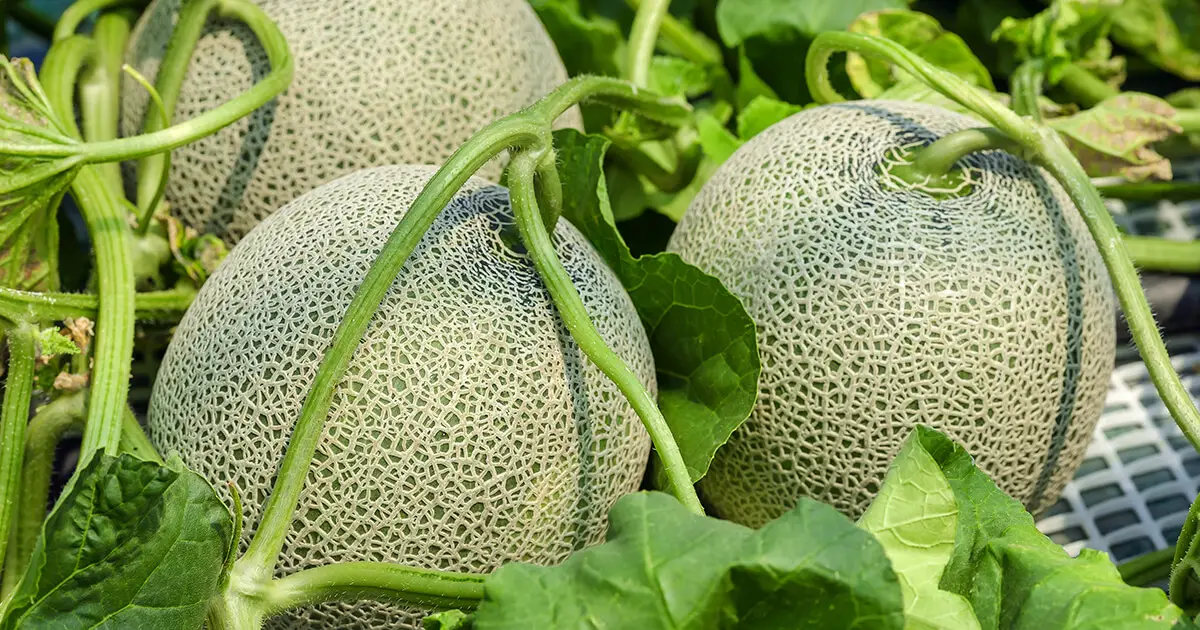The cantaloupe plant is a warm loving fruit which has a long growing season. Today we'll show you how to grow cantaloupe in your own garden and enjoy this delicious, healthy fruit all season long! Cantaloupes are actually a type of muskmelon, and so, they're actually not really cantaloupes at all, though most people call them cantaloupes. For the sake of avoiding confusion, we'll refer to the fruit as a cantaloupe and not muskmelon.
Growing cantaloupe is fairly easy, provided you follow the growing guide below. They like warm weather, sun, and regular watering.
Also called mushmelon, rockmelon, and sweet melon, (Spanspek in South Africa), the cantaloupe plant is a variety of the Cucumis melo species that is part of the Cucurbitaceae family.
Accroding to researchers, the cantaloupe may have originated from South Asia to Africa. Eventually, it was introduced to Europe, the United States, and Canada. Keep reading to learn how to grow cantaloupe in your garden!
How to Grow Cantaloupe in Your Garden

Cantaloupe Plant Requirements:
Growing cantaloupe requires a few specific things in order for good, healthy growth.
Light Requirement:
Cantaloupe plants require full, direct sun. This is usually 6-8 hours of sunlight per day.
Planting Space:
Plant each cantaloupe seed about 36 to 42 inches apart. Cantaloupes have vines, so make sure they have enough space to spread around.
Soil:
Grow melons using nutrient-rich, well draining soil mixed in with organic matter. Be sure to work at least 3-4 inches of organic matter into the soil, and ensure that soil temperature is at least 70F (21C), before planting cantaloupe seeds.
Watering:
In order for cantaloupe plants to grow successfully, the soil needs to be consistently moist. Be sure to water during its growing season. Adding mulch helps to retain moisture, especially during droughts. Do not water on the leaves, but rather directly into the soil.
Frost Prevention:
Even the slightest amount of frost will kill cantaloupe vines. In order to protect the fruit and the vines, use frost blankets or cold frames. To make sure that the remaining cantaloupe fruits will ripen before the frost, remove any blossoms that start to develop within 50 days of your region's average frost date.
Planting Cantaloupe:
- Before planting, amend the soil with compost or manure.
- We recommend growing cantaloupes in raised rows which ensures good drainage.
- If you live in a cooler climate, start seeds indoors a month before transplanting.
- Cantaloupe seedlings are very sensitive, so do not transplant until all danger of spring frost has passed.
- If you live in a warmer climate, you can sow seeds directly outdoors as long as the soil temperature is at least 65F.
- Plant the seeds once inch deep, 18 inches apart, and 3 feet apart in hills.
- If you don't have a lot of space, you can train the vines to be supported on a trellis or a fence.
Caring for Cantaloupe:
- Add lots of compost to the area before transplanting as cantaloupes like loamy, well drained soil.
- Mulch with black plastic to warm the soil and hinder weed growth.
- Fertilize once the vines start growing.
- Water about 1-2 inches per week while your cantaloupes are growing.
- Reduce watering once once fruit are growing. Cantaloupes taste sweeter in dry weather.
- Once fruit has begun to grow, prune end buds off vines.
Harvesting Cantaloupe:
- Most varieties will be ready to harvest between 70-90 days.
- Once rinds from green to tan or yellow, your cantaloupe is ready to be harvested.
- Harvest cantaloupe while vines are dry.
Cantaloupe Pests and Diseases:
- Watch out for the following pests: aphids, and striped and spotted cucumber beetles.
- Keep an eye out for the following diseases: alternaria leaf spot, gummy stem blight, anthracnose, downy mildew, and powdery mildew.
Happy planting!





















To tell the truth, cantaloupe is my favorite kind of fruit because it is so fresh and it has its own special taste. It is so good that I came across your article because I would like to know how I can grow it for the reason that I would eat it practically every day. It is so wonderful that these tips are applicable not only for people who have fully favorable conditions to grow cantaloupe but for almost any person. Frankly, I wasn’t aware of the fact that there are such a variety of cultivars of cantaloupe and they… Read more »